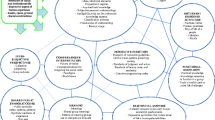Abstract
Four value commitments act as barriers to the development of sociocultural indicators. First, no specialists exist to develop socio-cultural indicators. Second, society is seen only as an order-seeking entity. Third, we fail to see the phenomenon as a living system. Fourth, our commitment to a pseudo-pragmatism dictates that such indicators must be ‘useful’ to those who bankroll their collection. Perhaps systems philosophers should be contracted to guide the task.
Similar content being viewed by others
Bibliography
Anderson, James G.: 1973, ‘Causal Models and Social Indicators: Toward the Development of Social Models’, American Sociological Review 38 (June), 285–301.
Bauer, Raymond A. (ed.): 1966, Social Indicators, the MIT Press.
Broom, Leonard and Selznick, Philip: 1973, Sociology, McGraw Hill.
Buckley, Walter: 1967, Sociology and Modern Systems Theory, Prentice-Hall.
Cassierer, Ernst: 1951, The Philosophy of the Enlightenment, Princeton University Press.
Dewey, John: 1934, Art As Experience, Capricorn, G. P. Putnam, 1958.
Ferriss, Abbott L.: 1975, ‘National Approaches to Developing Social Indicators’ in Systems Thinking and the Quality of Life, Proceedings of the 1975 Annual North American Meeting Society for General Systems Research, New York, Jan. 27–30, 1975.
Henshel, Richard L.: 1976, On the Future of Social Prediction, Bobbs-Merrill Co.
Kasarda, John D.: 1974, ‘Structural Implications of Social System Size: A Three Level Analysis’, American Sociological Review 34, 19–28.
Land, Kenneth C.: 1971, ‘On the Definition of Social Indicators’, The American Sociologist 6, 322–5.
Laszlo, Ervin: 1973, Introduction to Systems Philosophy, Harper and Row.
Moore, Wilbert and Cook, Robert: 1968, Readings in Social Change, Prentice Hall.
Nelson, Charles W. and Smith, Eugene V.: ‘Achieving Institutional Adaptation Using Diagonally Structured Information Exchange’, Human Relations 27, 101–119.
Nisbet, Robert: 1973, The Social Philosophers: Community and Conflict in Western Thought, Thomas Y. Crowell.
Oltmans, William L.: 1974, On Growth, The Crises of Exploding Population and Resource Depletion, Capricorn Books, G. P. Putnam's Son, New York.
Sheldon, Eleanor B. and Freeman, Howard: 1970, ‘Notes on Social Indicators: Promises and Potential’, Policy Sciences, April, pp. 97–111.
Smith, E. V.: 1976, A Sociology of Terror in Popular Artforms, Sociological Abstracts, May 1976, 505610, NCSA 02 75.
U.S. Department of Health, Education and Welfare: 1969, Toward a Social Report, Washington, D.C., U.S. Government Printing Office.
Whitehead, Alfred N.: 1938, Modes of Thought, Lecture 8, ‘Nature Alive’, Macmillan Co., New York.
Wilcox, Leslie D. and Brooks, Ralph M.: 1971, ‘Toward the Development of Social Indicators for Policy Planning’, Paper Presented at the Annual Meeting of the Ohio Valley Sociological Society, Cleveland.
Wilcox, Leslie, Brooks, Ralph M., Beal, George M., and Klonglan, Gerald M.: 1972, Social Indicators and Societal Monitoring, Jossey-Bass, San Francisco.
Yancey, William, Ericksen, Eugene, and Juliani, Richard: 1976, ‘Emergent Ethnicity: A Review and Reformulation’, American Sociological Review 41, No. 3.
Author information
Authors and Affiliations
Rights and permissions
About this article
Cite this article
Smith, E.V. Four issues unique to socio-cultural indicators. Social Indicators Research 5, 111–120 (1978). https://doi.org/10.1007/BF00352923
Received:
Issue Date:
DOI: https://doi.org/10.1007/BF00352923




